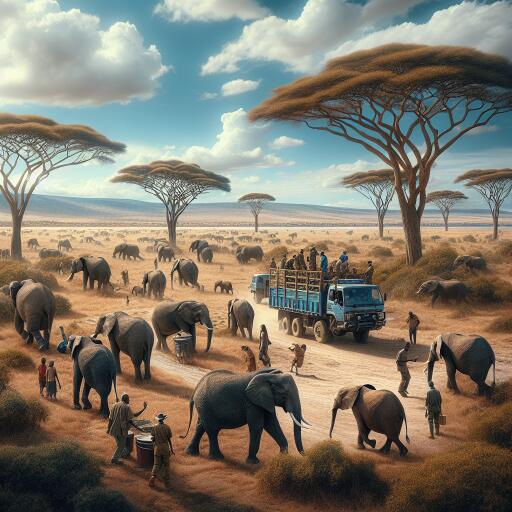
Kenya Begins Translocation of Elephants to Boost Human-Wildlife Coexistence
Nairobi, Oct 4 – The Kenya Wildlife Service (KWS) has embarked on a significant elephant translocation project aimed at enhancing the coexistence between humans and wildlife, as well as conserving wildlife habitats. This initiative involves the relocation of nearly 50 elephants from the Mwea National Reserve to the Aberdare National Park, both situated in central Kenya.
The endeavor is part of the broader National Elephant Action Plan for 2023-2032, a blueprint designed by KWS and affiliated organizations. The plan emphasizes maintaining a sustainable elephant population, diminishing conflicts between humans and elephants, and revitalizing deteriorated habitats.
Furthermore, the translocation aligns with the newly implemented KWS Strategic Plan for 2024-2028, which prioritizes advanced conservation methods, community involvement, and technology integration. The initiative is expected to decrease the strain on Mwea National Reserve, where the elephant count has grown exponentially from 49 in 1979 to 156 in current times. This surge has led to considerable property destruction, including damage to residences and agricultural lands, alongside increasing human-elephant confrontations.
The translocation is considered vital for safeguarding both the elephants’ welfare and the well-being of neighboring communities, the majority of whom engage in subsistence farming. By bolstering the elephant population in the more extensive Aberdare National Park, ecological equilibrium is anticipated to be achieved, potentially boosting ecotourism and delivering economic advantages to the local populations.
Kenya’s cabinet secretary in the Ministry of Tourism and Wildlife, Rebecca Miano, who supervised the translocation, noted that this move would enrich the genetic variety of the elephant populace, defend endangered species, and enhance ecosystem resilience. She emphasized Kenya’s commitment to international frameworks aimed at enhancing elephant conservation as these majestic creatures face numerous challenges, such as poaching, habitat reduction, and climate-induced pressures.
According to Erustus Kanga, the director-general of the KWS, the elephant relocation initiative forms part of the strategic actions directed toward tackling habitat degradation and human-wildlife conflicts, which additionally aims to uplift the socio-economic conditions of communities teetering on the edges of wildlife reserves.
This project signifies a step forward in Kenya’s commitment to safeguarding its rich biodiversity and ensuring a harmonious existence where humans and wildlife thrive together. By embracing modern conservation strategies and fostering active community participation, it represents a model approach to addressing the pressing issues of wildlife conservation today.





Leave a Reply